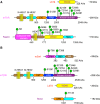Targeting mTOR for cancer therapy
- PMID: 31277692
- PMCID: PMC6612215
- DOI: 10.1186/s13045-019-0754-1
Targeting mTOR for cancer therapy
Abstract
Mechanistic target of rapamycin (mTOR) is a protein kinase regulating cell growth, survival, metabolism, and immunity. mTOR is usually assembled into several complexes such as mTOR complex 1/2 (mTORC1/2). In cooperation with raptor, rictor, LST8, and mSin1, key components in mTORC1 or mTORC2, mTOR catalyzes the phosphorylation of multiple targets such as ribosomal protein S6 kinase β-1 (S6K1), eukaryotic translation initiation factor 4E binding protein 1 (4E-BP1), Akt, protein kinase C (PKC), and type-I insulin-like growth factor receptor (IGF-IR), thereby regulating protein synthesis, nutrients metabolism, growth factor signaling, cell growth, and migration. Activation of mTOR promotes tumor growth and metastasis. Many mTOR inhibitors have been developed to treat cancer. While some of the mTOR inhibitors have been approved to treat human cancer, more mTOR inhibitors are being evaluated in clinical trials. Here, we update recent advances in exploring mTOR signaling and the development of mTOR inhibitors for cancer therapy. In addition, we discuss the mechanisms underlying the resistance to mTOR inhibitors in cancer cells.
Keywords: Cancer; Drug resistance; Oncogene; Targeted therapy; mTOR.
Conflict of interest statement
The authors declare that they have no competing interests.
Figures


Similar articles
-
Targeting the mTOR pathway in tumor malignancy.Curr Cancer Drug Targets. 2013 Mar;13(3):267-77. doi: 10.2174/1568009611313030005. Curr Cancer Drug Targets. 2013. PMID: 23297825 Review.
-
[mTOR inhibitor].Gan To Kagaku Ryoho. 2011 Jan;38(1):7-11. Gan To Kagaku Ryoho. 2011. PMID: 21368454 Japanese.
-
mTOR kinase inhibitors as potential cancer therapeutic drugs.Cancer Lett. 2013 Oct 28;340(1):1-8. doi: 10.1016/j.canlet.2013.06.017. Epub 2013 Jun 20. Cancer Lett. 2013. PMID: 23792225 Free PMC article. Review.
-
Targeted Inhibition of Rictor/mTORC2 in Cancer Treatment: A New Era after Rapamycin.Curr Cancer Drug Targets. 2016;16(4):288-304. doi: 10.2174/1568009616666151113120830. Curr Cancer Drug Targets. 2016. PMID: 26563881 Review.
-
RES-529: a PI3K/AKT/mTOR pathway inhibitor that dissociates the mTORC1 and mTORC2 complexes.Anticancer Drugs. 2016 Jul;27(6):475-87. doi: 10.1097/CAD.0000000000000354. Anticancer Drugs. 2016. PMID: 26918392 Free PMC article. Review.
Cited by
-
Reprograming immunosuppressive microenvironment by eIF4G1 targeting to eradicate pancreatic ductal adenocarcinoma.Cell Rep Med. 2024 Oct 15;5(10):101731. doi: 10.1016/j.xcrm.2024.101731. Epub 2024 Sep 19. Cell Rep Med. 2024. PMID: 39303711 Free PMC article.
-
Combining mTOR Inhibitors and T Cell-Based Immunotherapies in Cancer Treatment.Cancers (Basel). 2021 Mar 17;13(6):1359. doi: 10.3390/cancers13061359. Cancers (Basel). 2021. PMID: 33802831 Free PMC article. Review.
-
Tumor Immune Evasion Induced by Dysregulation of Erythroid Progenitor Cells Development.Cancers (Basel). 2021 Feb 19;13(4):870. doi: 10.3390/cancers13040870. Cancers (Basel). 2021. PMID: 33669537 Free PMC article. Review.
-
Negative regulator NLRC3: Its potential role and regulatory mechanism in immune response and immune-related diseases.Front Immunol. 2022 Oct 20;13:1012459. doi: 10.3389/fimmu.2022.1012459. eCollection 2022. Front Immunol. 2022. PMID: 36341336 Free PMC article. Review.
-
Comparison of dual mTORC1/2 inhibitor AZD8055 and mTORC1 inhibitor rapamycin on the metabolism of breast cancer cells using proton nuclear magnetic resonance spectroscopy metabolomics.Invest New Drugs. 2022 Dec;40(6):1206-1215. doi: 10.1007/s10637-022-01268-w. Epub 2022 Sep 5. Invest New Drugs. 2022. PMID: 36063263
References
Publication types
MeSH terms
Substances
LinkOut - more resources
Full Text Sources
Other Literature Sources
Research Materials
Miscellaneous

